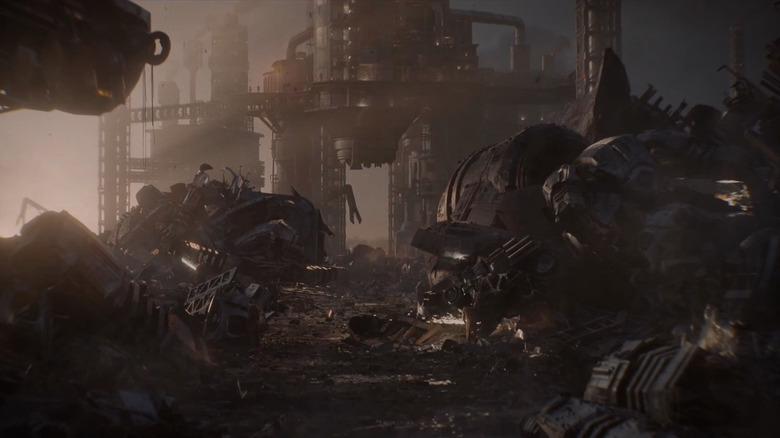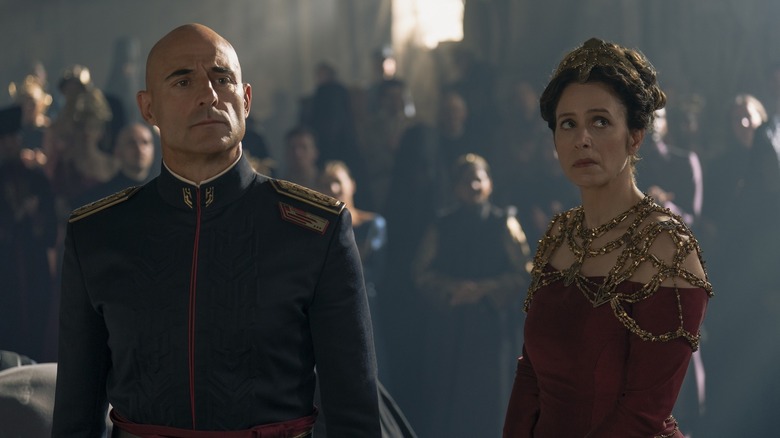Warning: The spoilers must flow. This article discusses major plot details from the latest episode of “Dune: Prophecy.”
When it was first announced that the recent “Dune” adaptations would receive their very own spinoff series, it’s fair to say that many fans had one main question: Why? Both blockbusters had managed to do the impossible and turn author Frank Herbert’s nerdy sci-fi/fantasy story into a mainstream sensation, reinforcing the idea that only a filmmaker like Denis Villeneuve had cracked the code. What more could a streaming show, even one about the space-witch society known as the Bene Gesserit, possibly accomplish? (For more on that, you can check out my review of “Dune: Prophecy” for /Film here.)
Well, it only took the opening scene for showrunner Alison Schapker, co-developer Diane Ademu-John, and their writing team to make a statement and add their own significant contribution to the franchise’s sprawling lore — something that even the movies never dared to depict.
Those who know their “Dune” history know that the destiny of Paul Atreides began long, long before he ever arrived on the desert world of Arrakis. “Dune: Prophecy” is set 10,000 years before the events of the first film, but the premiere actually digs even further back than that. In a flashback sequence that plays out similarly to the prologue of “The Lord of the Rings: The Fellowship of the Ring,” we travel all the way to the war that forever changed the fate of humankind: the Butlerian Jihad. Although never actually named as such in the series (thankfully, considering its awfully clunky implications), the effects of this conflict reverberate throughout the rest of the plot and the universe as a whole. Here’s why this was such a big deal.
Did somebody order a Butlerian Jihad?
Most major fantasy epics feature an inciting event — typically violent — that sets everything in motion. In “The Lord of the Rings,” it’s the (presumed) defeat of the Dark Lord Sauron on the slopes of Mount Doom and the ill-fated choice not to destroy his One Ring right then and there. With “Game of Thrones,” the uprising known as Robert’s Rebellion, which overthrew the Mad King and brought a new non-Targaryen dynasty to Westeros, set the stage. For “Dune: Prophecy,” the series settles on perhaps the most fascinating and mysterious war in the entire universe: the Butlerian Jihad.
Ever wonder why none of the futuristic sci-fi tech scattered throughout “Dune” seems to contain artificial intelligence, computers, or any other sentient “thinking machines” (as they’re called in the novels)? Well, you can blame the fact that humanity once was enslaved by the very robots they created, and only barely managed to free themselves from their man-made oppressors. Roughly 100 years before the present-day storyline of “Dune: Prophecy,” revolutionaries waged a generations-long war against AI and computerized machines that had apparently become a little too smart and self-sufficient for their own good. This rebellion plays a massive role in the development of the human race, leading to a sweeping backlash against any piece of technology reliant upon “thinking machines,” computerized intelligence, and robots in general.
According to the lore (only one expanded-universe novel written by Herbert’s son, titled “The Butlerian Jihad”, is set during this time period), such quasi-religious fanaticism on a broad scale resulted in the total eradication of smart tech, the introduction of strict laws against their use, and the rise of human alternatives: namely, the Bene Gesserit.
How Dune: Prophecy deals with the aftermath of the Butlerian Jihad
Although repeatedly referenced in many of the novels, the “Dune” movies never once directly mention this armed conflict. That changes decisively with “Dune: Prophecy,” turning this epic war into an origin story of sorts.
First, we find out that the Butlerian Jihad indirectly caused the bitter rivalry between House Atreides and House Harkonnen (which, of course, makes it all the more ironic that “Dune: Part Two” incorporates a major twist linking both families). A leading figure of the Harkonnens is branded a coward for deserting their post, forever tarnishing their entire house, while an Atreides helps lead humanity to victory and steals all the glory. Naturally, this historic injustice — the Harkonnens believe this was based on a lie — motivates our vengeful main protagonist Valya Harkonnen (Emily Watson) to become a member of the Bene Gesserit (then known as the Sisterhood) and wield influence among the Great Houses from the inside out — mainly through their genetic program and their attempts to create leaders who will be sympathetic to their agenda.
Secondly, the effects of the Butlerian Jihad are felt most dramatically in the engagement of Princess Ynez Corrino (Sarah-Sofie Boussnina) and Prince Pruwet of House Richese (Charlie Hodson-Prior) and beyond. When the young boy inadvertently reveals that he has a mechanical toy in his possession, the scandal threatens to blow up what seemed like a promising political match (despite their alarming age difference). Although it might not appear to be a big deal, the taboo of anything remotely capable of thinking for itself is enough to send shockwaves through humans who have been conditioned to mistrust and even fear these machines. This fear is what gives factions like the Sisterhood an opportunity to seize power for themselves, offering their “truthsayer” abilities as an indispensable tool for the Emperor and other leaders. However, that deep-rooted fervor against machines is also what drives the enigmatic soldier Desmond Hart (Travis Fimmel), ultimately leading to his assassination of the young prince and the rise of a new enemy for the Bene Gesserit.
New episodes of “Dune: Prophecy” hit HBO and stream on Max every Sunday.
This post was originally published on here









